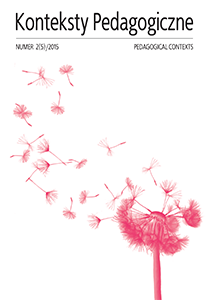Abstract
A teacher working in a modern school is obliged to shape and enrich personalities of entrusted to him or her young people and hence to assist them in their way to develop their potential. In the process of shaping children’s and young people personality music performs a significant role. It directly affects the emotional state of human and becomes an important means of social interaction. The aim of this study is to attempt to draw attention that a certain kind of music – relaxing music – is becoming an important element of the human development.In our view, relaxing music becomes a kind of language that conveys important pedagogical content often impossible to express verbally. This type of music used by a teacher as part of the educational processes has a significant impact on human emotions and moods. It may calm, stimulate, create specific moods, reduce stress. The impact of relaxing music on the human emotional states may be, under certain circumstances, greater than the impact of verbal or visual arts. Applied in educational activities relaxing music allows to teach innovatively and creatively, it is the realization of children’s right to awake interest in acquiring knowledge. It stimulates the natural instinct of curiosity. The above mentioned goals of conducting classes with the use of relaxing music are the foundations of the following study.
References
Badeni J., Autobiografia. Z ojcem Joachimem Badenim rozmawiają Artur Sporniak i Jan Strzałka, Kraków 2004.
Day J., Twórcza wizualizacja dla dzieci, przeł. B. Malwina, Poznań 1997.
Denek K., Kształcenie i doskonalenie nauczyciela w kontekście jego twórczości, [w:] Twórczy rozwój nauczyciela, red. S. Juszczyk, Kraków 1996.
Dziecko w świecie muzyki, red. B. Dymara, Kraków 2000.
Edukacja artystyczna jako edukacja kreatywna, red. K. Piątkowska-Pieczewska, Poznań–Kalisz 2009.
Ferguson M., Die sanfte Verschwörung, Basel 1982.
Górniok-Naglik A., Muzyka a rozwój małego dziecka, [w:] Dziecko w świecie muzyki, red. B. Dymara, Kraków 2000.
Grzegorczyk A., Humanistyka i obecność, Poznań 2014.
Guczalski K., Znaczenie muzyki. Znaczenia w muzyce, Kraków 2002.
Kamińska B., Nauczyciel muzyki w nowoczesnej szkole, [w:] Edukacja artystyczna jako edukacja kreatywna, red. K. Piątkowska-Pieczewska, Poznań–Kalisz 2009.
Klemens Aleksandryjski, Zachęta Greków, [w:] Apologie, przeł. M. Szarmach, A. Świ-derkówna, J. Sołowianiuk (Pisma Starochrześcijańskich Pisarzy, t. 44), Warszawa 1988.
Knopik T., Czas wolny... od nudy. Zrównoważony rozwój uczniów zdolnych w ramach zajęć pozalekcyjnych, Warszawa 2014.
Kompetencyjny kontekst warsztatu pracy nauczyciela, red. P.P. Barczyk, G. Paprocka, My-słowice 2010.
Kowolik P., Obszary kompetencji zawodowych współczesnego nauczyciela, [w:] Kompetencyjny kontekst warsztatu pracy nauczyciela, red. P.P. Barczyk, G. Paprocka, Mysłowice 2010.
Kozielecki J., Koncepcja transgresyjna człowieka. Analiza psychologiczna (Biblioteka Psy-chologii Współczesnej), Warszawa 1987.
Łukawiecka A., Uczeń czy człowiek, [w:] Szkoła: edukacja, dialog, partnerstwo, red. J. Kropiwnicki (Biblioteka „Nowego w Szkole” 2), Jelenia Góra 1998.
Magda-Adamowicz M., Dziecko twórcze muzycznie, [w:] Wartości w muzyce. Muzyka w środowisku społecznym, t. 4, red. J. Uchyła-Zroski, Katowice 2012.
Natanson T., Wstęp do nauki o muzykoterapii, Warszawa 1979.
Platon, Faidros, przeł. I. Regner, Warszawa 1993.
Platon, Państwo, III, przeł., wstępem i komentarzem opatrzył W. Witwicki, Kęty 2003.
Poezja dla dzieci. Antologia form i tematów, red. R. Waksmund, Wrocław 1999.
Rolland R., List do Lwa Tołstoja z 24.01.1897 r., [w:] A. Górniok-Naglik, Muzyka a rozwój małego dziecka, [w:] Dziecko w świecie muzyki, red. B. Dymara, Kraków 2000.
Santorski J., Jak żyć, żeby nie zwariować, Warszawa 1997.
Siek S., Autopsychoterapia, Warszawa 1985.
Słownik wyrazów obcych, red. J. Tokarski, Warszawa 1971.
Szatan E., Przestrzeń muzyczna dziecka w wymiarze klasy szkolnej, „Konteksty Pedago-giczne” 2015, nr 1 (4).
Szatan E. W poszukiwaniu radosnych (?) spotkań dzieci z muzyką w kształceniu zintegrowanym (o krytycznorefleksyjnym modelu pracy nauczyciela), [w:] Pomiędzy dwiema edukacjami. Nauczyciel wczesnej edukacji dziecka wobec czasu zmiany, red nauk. I. Adamek, B. Olszewska, Łódź 2014.
Szuścik U., Muzyka i dzieło plastyczne, [w:] Dziecko w świecie muzyki, red. B. Dymara, Kraków 2000.
Twórczy rozwój nauczyciela, red. S. Juszczyk, Kraków 1996.
Wartości w muzyce. Muzyka w środowisku społecznym, t. 4, red. J. Uchyła-Zroski, Ka-towice 2012.
Woltman-Mazurkiewicz L., Muzyka relaksacyjna w edukacji, [w:] Dziecko w świecie muzyki, red. B. Dymara, Kraków 2000.
In accordance with the recommendation of the Ministry of Science and Higher Education, which aims to counteract the practice of “ghostwriting” and “guest authorship,” all authors submitting their text for publication should attach an author’s statement which declares the contribution of each of the authors to the article. The printed and signed statement should be delivered by mail or other means to editor-in-chief Joanna Skibska or sent in the form of a scan to the following e-mail address: redakcja@kontekstypedagogczne.pl. The authors will not receive remuneration for publishing their papers. The editors reserve the right to make minor editorial changes to the articles which will not affect the substance of the article. We encourage all authors to prepare their articles in accordance with the guidelines for manuscript preparation. Download pdf file.
Authors transfer all copyrights and grant the journal the right of first publication with the work simultaneously licensed under a Creative Commons Attribution License that allows others to share the work with acknowledgement of the work's authorship and initial publication in this journal. All authors agree to the publishing of their email addresses, affiliations and short bio statements with their articles during the submission process.

